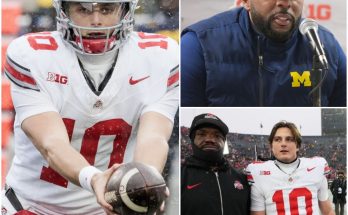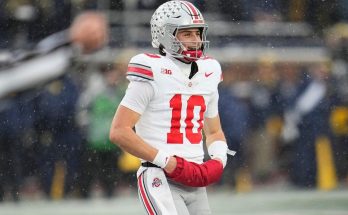When it comes to electrifying performances on the football field, Ty Simpson has been making waves for all the right reasons. The young quarterback, known for his poise, accuracy, and field vision, has recently captured the attention of fans and analysts alike with a series of high-caliber games that showcased not just his physical skills but also his mental toughness. What’s more impressive is the way Simpson has embraced full leadership mode, not merely leading by statistics but by example, inspiring his teammates to elevate their play and rise to challenges with confidence.
Simpson’s journey to becoming a dominant force in the offense was never one defined solely by raw talent. From the early stages of his career, he demonstrated a commitment to growth that went beyond the mechanics of throwing the ball. It was a blend of meticulous preparation, mental discipline, and an innate understanding of the game that allowed him to consistently make high-impact plays. When he lit up the offense, it wasn’t a product of luck or circumstantial advantage; it was the culmination of years of focus, countless hours in the film room, and a relentless drive to push both himself and those around him to new heights.
One of the most striking elements of Simpson’s performance this season has been his ability to read defenses and adjust on the fly. In recent games, there have been multiple instances where what initially seemed like a collapsing pocket turned into a strategic advantage for the offense. Simpson’s eyes scan the field with precision, quickly identifying weak points and predicting defensive movements before they happen. His decision-making under pressure is a hallmark of a player who has invested not only in athletic training but also in understanding the chess-like complexity of football. This cognitive edge allows him to create opportunities where others might see only risk, transforming potential breakdowns into highlight-reel plays.
However, it isn’t just Simpson’s physical or cognitive skills that have propelled him into the spotlight; it is his leadership on and off the field. Teammates describe him as a quarterback who takes ownership of both victories and setbacks, someone who holds himself accountable while lifting others up. Leadership in football is often measured by how well a player can command the huddle, communicate strategies, and maintain morale in the face of adversity. Simpson excels in all these areas. After particularly grueling games, he can often be found speaking to his teammates, breaking down what went right, what went wrong, and how the group can collectively improve. His presence brings a sense of calm urgency, a recognition that while the game is high-stakes, the path to success is built on discipline, preparation, and trust.
In interviews following standout performances, Simpson has emphasized that the offense’s success is never his alone. “I can throw the ball perfectly, but if my receivers don’t run the right routes, or if the offensive line doesn’t give me time, it doesn’t matter,” he said. This perspective reflects a maturity that is rare for a player of his age. He understands that football is the ultimate team sport, where victories are the product of countless moving parts working in harmony. By framing his contributions within the larger context of team effort, Simpson not only elevates his own game but also reinforces a culture of accountability and mutual respect among his teammates.
Another factor that has contributed to Simpson’s offensive explosion is his adaptability. Football is a game of adjustments, and defenses are constantly evolving to counteract even the most talented quarterbacks. Simpson has shown an uncanny ability to pivot mid-game, whether it’s altering his approach to a particular defensive scheme or leveraging the unique strengths of his receiving corps. In one recent matchup, a defensive strategy designed to shut down the passing game backfired spectacularly, thanks to Simpson’s quick recognition and tactical improvisation. By the end of the game, his statistics reflected a quarterback in complete command of the offense, seamlessly blending preparation with instinctual playmaking.
While fans naturally gravitate toward stats like touchdowns and completion percentages, Simpson’s impact runs deeper. His leadership has fostered a culture in which young players feel empowered to take risks, learn from mistakes, and step into larger roles within the offense. This ripple effect transforms individual talent into cohesive team performance. Coaches frequently note that Simpson’s presence has allowed them to be more creative in their play-calling, confident that the quarterback can execute complex schemes under pressure. It is the kind of dynamic that turns good offenses into great ones, where the quarterback is both a catalyst and a stabilizing force.
Ty Simpson’s dedication to leadership extends beyond the practice field. He invests time in mentoring younger athletes, sharing insights on preparation, mental focus, and resilience. Many of these lessons, drawn from both personal experience and observation, revolve around the idea that leadership is about influence, not authority. Simpson’s teammates respond to this approach because it is genuine; he doesn’t demand respect—he earns it by being consistent, approachable, and committed to excellence. These qualities manifest during games when the offense is in critical moments, allowing the team to function almost instinctively under pressure.
It is also worth noting that Simpson’s performance has had a broader impact on the program as a whole. Attendance at games has risen, social media buzz has grown, and the team’s reputation as a competitive powerhouse has solidified. Beyond the Xs and Os, Simpson embodies the excitement and energy that draw fans and recruits alike. His ability to light up the offense energizes not only the players on the field but also the entire community surrounding the team. In this way, leadership extends beyond the locker room, shaping perceptions and creating momentum that transcends individual games.
Simpson himself attributes much of his growth to a combination of mentorship and personal accountability. Coaches, veteran players, and even family members have helped him refine his approach to both the mental and physical aspects of football. But he also emphasizes self-reflection as a key driver of improvement. Reviewing game film, analyzing mistakes, and setting concrete goals for each practice session are all part of his regimen. The result is a quarterback who is constantly evolving, always looking for ways to enhance his decision-making, arm strength, and tactical awareness.
What sets Simpson apart is the balance between confidence and humility. He is confident enough to take calculated risks and lead the offense in high-pressure situations, yet humble enough to acknowledge when adjustments are necessary. This equilibrium allows him to maintain composure in the most intense moments of the game. Opposing defenses often underestimate this duality at their peril; they might see a talented quarterback, but they are unprepared for the combination of mental acuity, leadership, and adaptability that Simpson brings to the field.
Ty Simpson’s offensive dominance is not merely a story of talent; it is a story of preparation meeting opportunity, of leadership blending with skill, and of a young athlete embracing his role to inspire those around him. His journey highlights the multifaceted nature of quarterbacking in modern football—where success is measured not just in yards and touchdowns but in influence, resilience, and the ability to elevate a team in both tangible and intangible ways.
As the season progresses, all eyes will remain on Simpson to see how he continues to develop and lead. For fans, analysts, and aspiring athletes, his performances serve as a case study in how leadership and talent intersect to produce truly memorable football. By lighting up the offense, Simpson is not just winning games; he is shaping a culture, setting standards, and demonstrating that leadership in sports is about action, vision, and the relentless pursuit of excellence.
In the end, Ty Simpson’s story is a testament to what happens when preparation, skill, and leadership converge. His ability to dominate the offense while inspiring those around him ensures that he will not only be remembered for the plays he makes but also for the culture he cultivates. The full leadership mode that Simpson has embraced is a blueprint for success, demonstrating that true greatness in football is as much about character and influence as it is about talent and statistics.
Simpson’s rise is a reminder that in football, as in life, the most impactful leaders are those who elevate others while striving for personal excellence. His journey continues to unfold, and one thing is certain: Ty Simpson isn’t just lighting up the offense—he’s lighting the path for everyone around him, leaving an indelible mark on the program and setting a standard that will resonate for years to come.



